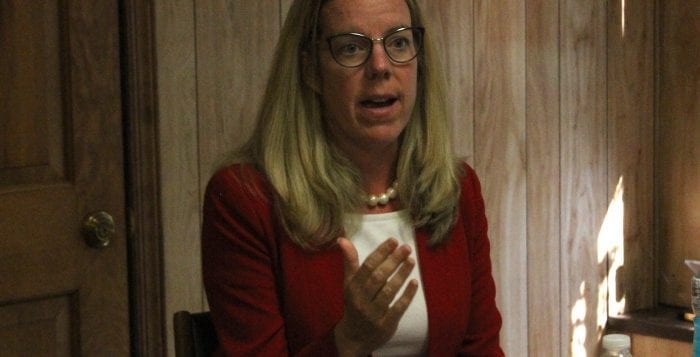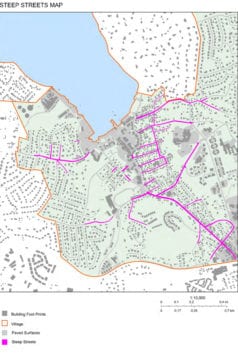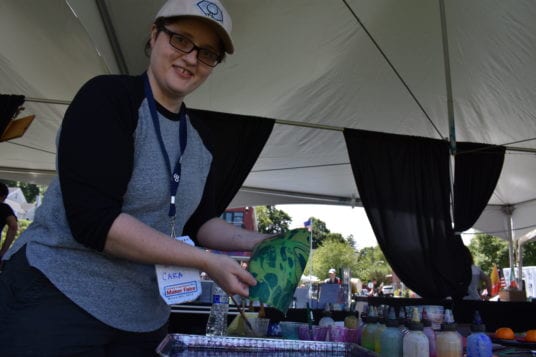The crab and the sea turtle, both species harmed by trash in the oceans, could be coming to Port Jeff to represent its beachfront and to remind visitors of the importance of protecting the oceans.

Two sculptures, one of each animal, are slated to come into the village courtesy of two artists, one with decades of experience, the other just beginning his artistic career.
Village of Port Jefferson trustees voted Nov. 2 to appropriate a total of $2,600 from the Farmers Market and Maritime Festival trust accounts to purchase the rights to the designs for the two sculptures. The pieces are designed to be filled with debris people might find on the beach to illustrate visually what is needed to keep both beaches and local waters clean. A similar statue was installed at Sunken Meadow State Park in Kings Park last year. (For more info, search “Shelley the Sea Turtle” at tbrnewsmedia.com.)
Village trustee Rebecca Kassay, who has a background in environmental activism, started work alongside other local leaders before she became trustee in September. She said she, Mayor Margot Garant and PJ resident Karen Levitov had seen some examples of these sculptures all over the world, and thought Port Jefferson, as a harborfront community, needed one as well.
“We thought, ‘How cool would it be to have a unique version in Port Jeff?’” Kassay said. “They’re functional — they’re empowering people not just to recycle, but be more conscious.”
One of the sculptures, also made to resemble a sea turtle, is designed by renowned artist Nobuho Nagasawa, a professor at Stony Brook University. Plans give two options for the turtle, one where the shell can be lifted and the trash dropped in, and another with the shell as a wire mesh. In her design document, Nagasawa said the artwork is inspired by “the wonderment of life in the ocean which is in danger.” The sculpture is destined for Harborfront Park.
Nagasaawa, with years of experience in the art world, said it was good training for artists only just coming into their own. The professor worked with Port Jefferson in helping the village format the request for qualification, which allowed them to establish what kind of cost estimates they were looking at.
The second sculpture, which the village hopes to install in Rocketship Park, resembles a giant crab, its pincers held up to the sky. SBU Undergraduate student Michael Manning wrote in his proposal that a crab is defensive, tenacious and can persevere, making it a great example to express the work to protect local waters. The crab’s thorax is a cage-like design, with one part made to hold trash and the other to hold bottles. Garant said they are looking to get the high school’s environmental club involved in designing a placard to go along with the sculpture.
“The crab was something we thought the kids could definitely get involved with,” she said. “We imagine the crab could become — like the horse is to Saratoga — the crab could be to Port Jefferson.”

Unlike other sculptures and pieces Nagasawa has worked on, even ones that had an interactive element, the professor said this was the first project where function was the main driving force. It was an interesting challenge for students, and now that Manning’s piece was chosen, the SBU art professor said she’s looking for the young artist, with some guidance from her, to carry through on the responsibility for getting the project completed. Her bigger hope is that the village considers even more such student art pieces in the future.
“I really appreciate the village trusted the students’ ability to make this proposal,” she said. “Students normally have very little chance of doing something like this, and I hope this can turn into something much bigger.”
Levitov, SBU’s Paul W. Zuccaire gallery director and curator, helped get the ball rolling with her connections to SBU’s artists. This project also dovetailed with an exhibition she was planning on environmental art.
Levitov said all the projects the committee received were “wonderful,” adding “the students were really innovative in their approaches — animal forms, glacial and nautical shapes, and baskets inspired by Native American weaving were all considered. “
“My hope is that this collaboration will lead to future opportunities for creative partnerships between Stony Brook University and the surrounding communities,” she said.
The 11 submissions were adjudicated by a committee that included Kassay, Garant and Levitov, as well as Lisa Perry, president of Port Jefferson Harbor Education & Arts Conservancy, and Port Jefferson Conservation Advisory Committee member Dreania LeVine. A decision was made on the two designs Oct. 26. They also gave an honorable mention to SBU student Marta Baumiller.
Kassay said the village is currently looking to work with Environmental Sculptures, a company that specializes in such designs and is responsible for the Sunken Meadow sculpture as well. The next step, the trustee said, is to apply for some environmental grants for the projects. Kassay added with her experience she expects it won’t be too difficult to acquire grants from for such projects, as they tick off “a lot of boxes.”
The trustee put the tentative date of fall 2021 for fabrication of the two sculptures.


























































